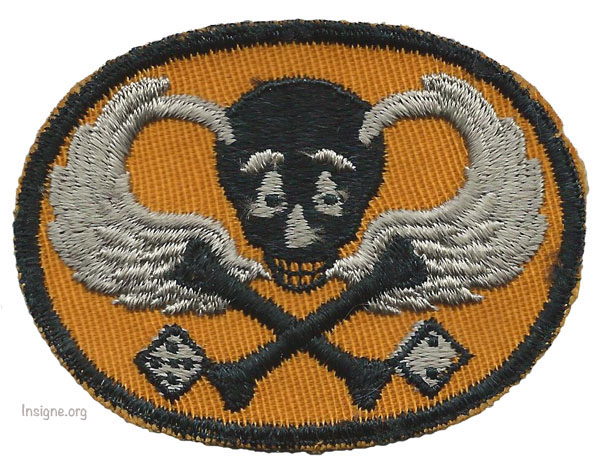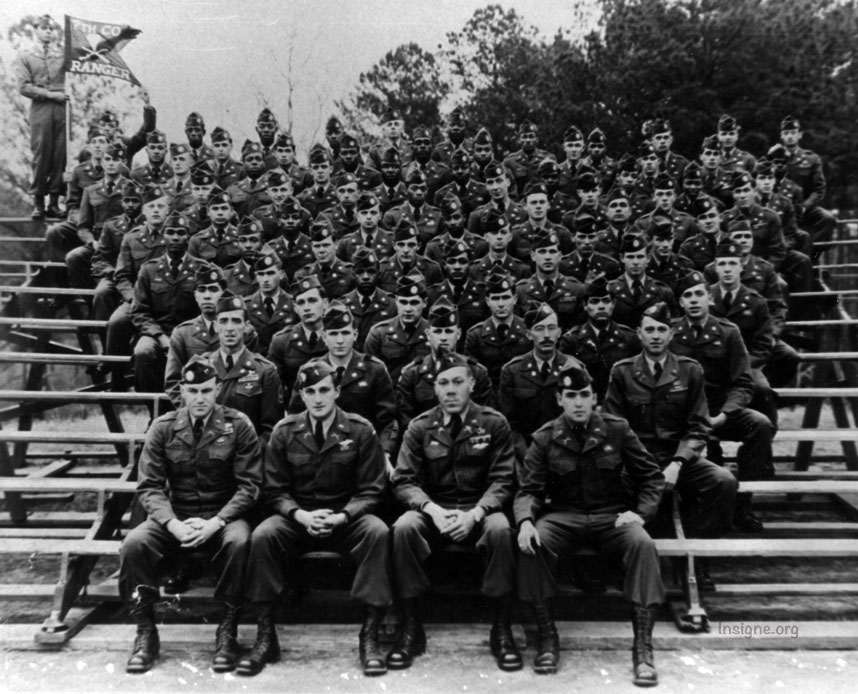|
|
The 7th Ranger Infantry Company (Airborne) Patch by Les Hughes ©1985 by author |
|
|
The material here, which first appeared a magazine article1, represents something of a departure from the other articles in this section in that rather than showing examples of fakes and reproductions of the patch in question, I illustrate only the genuine patch. Such an approach works in this instance because I am certain that only a single version of this patch is genuine. Although familiar to many collectors, the patch illustrated below is one that, nevertheless, is rarely identified correctly. Some references and, as a result, many collectors incorrectly attribute the patch to the 7th Ranger Battalion, a unit that was still in the planning stage when WWII ended. The patch, in fact, is that of the 7th Ranger Infantry Company (Airborne).
Example of genuine patch of 7th Ranger Company The 7th Ranger Company was one of 17 such companies, of which 15 were designated numerically (1st through 15th) and two by letters (A and B). The Airborne Ranger Companies of the Korean War were short-lived: training began in October 1950, and by December of the following year all had been disbanded.2 Six of the companies saw combat in Korea, but the 7th remained at Fort Benning, where it served primarily as a source of replacements for the other companies. Information that I gleaned from talking with veterans of the 7th indicated that the patch was created and worn early in the Company's existence. Although the identity of the designer of the patch is uncertain, the unit's first Commanding Officer and its First Sergeant (both of whom subsequently went to Korea with the 8th Ranger Company) apparently were the motivating forces behind the creation of the patch.3 The design employs a skull with crossbones flanked by wings in the style of those of the parachute qualification badge. A pair of dice whose faces sum to seven complete the design. These features are embroidered on a gold twill with a pronounced ribbed texture and a buckram backing. A number of variations of this patch exist. A catalog published by the American Society of Military Insignia Collectors describes the patch as being "on an orange elipse"; a patch guide for collectors illustrates a version on tan twill4; and I have seen two other versions. This leads to the question, which versions are genuine (made for wear by the unit) and which are reproductions? I am convinced that only the version illustrated here is genuine. These are the facts that led me to this conclusion. First, the unit was short-lived, and the patch even shorter lived. Second, the unit was small (see photo below). How many variations of such a patch would you reasonably expect to encounter in a unit of this size that existed for only a few months? Third, in 1984 I was put in touch with the widow of Robert Eikenberry, the first Commanding Officer of the 7th. At my request, Mrs. Eikenberry searched her husband's memorabilia and found a group photograph of the 7th (shown below) and a single example of this patch, which she sent to me.5 The patch that Mrs. Eikenberry found among her husband's effects was identical to the one illustrated here. A collector once told me that he had seen a photograph showing this patch being worn on a field jacket in lieu of jump wings. None of the veterans of the 7th with whom I spoke recalled such a practice. Those who recalled the patch stated that it was worn on the lower left sleeve of the khaki uniform in the fashion of the Pathfinder patch.
The 7th Ranger Infantry Company (Airborne), Ft. Benning, circa early 1951. Capt. Robert Eikenberry, front row, viewer's far left. Footnotes 1. Les Hughes, "The 7th Ranger Sleeve Patch." The Trading Post, Oct/Dec 1985. 2. For more information on the Airborne Ranger Companies of the Korean War, go to the Ranger Companies link at the left. 3. Col. Ludwig Feistenhammer, USA(ret.), private communication. 4. Jack Britton and George Washington, Jr., Military Shoulder Patches of the United States Armed Forces. (Tulsa: MCN Press) 1978. Intending this book as a guide to identification, the authors used reproductions when genuine examples were unavailable. Some collectors, unaware of this, have used the book to judge the authenticity of patches. 5. In accordance with Mrs. Eikenberry's wishes, both the photograph and patch were forwarded to The Military History Institute, Carlisle Barracks, PA, where they are part of the Ranger Collection. |


